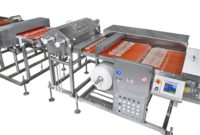Improvements in slaughtering

Processors face a variety of trials with slaughter equipment. It is a real challenge to design equipment that is durable, easy to maintain and capable of work cycling in environments that have large changes in temperature and humidity. In addition, processors still need to protect workers and be concerned about food safety.
The slaughtering environment itself creates the need for special attention to be paid to achieve optimum processing.
“In the high-humidity and variable-temperature environment that we find in slaughter operations, upkeep is key,” says Kurt Vogel, assistant professor of animal science at the University of Wisconsin – River Falls. “Good maintenance is vital to getting the best performance and longest service life from slaughter equipment.”
Although worker safety is of utmost importance during the slaughtering process, the steps that processors are taking to ensure worker safety aren’t necessarily revolutionary. They are simply investing the time and resources to focus on worker safety in facility and equipment design, training and day-to-day operations, Vogel says.
Slaughtering progress
Slaughter processes and techniques have changed considerably in the past few decades.
“We have seen more focus on installing intervention steps to protect food safety over the past few decades, and this trend has been moving further upstream in the slaughter facility,” Vogel says. “Twenty years ago, many processors were focused on installing knife sterilizers and steam-pasteurization equipment. In recent years, we have seen more focus on improving food safety while the hide is still intact with hide wash cabinets for use after stunning and antimicrobial treatments for animals before they leave the farm.”
Stunning also has improved remarkably in the past 15 years. Comparing a 1996 survey by Temple Grandin to stunning efficacy in the 2011 restaurant audits, the improvement is remarkable, Vogel says. For example, in 1996, 30 percent of the beef slaughter plants that Grandin audited for the U.S. Department of Agriculture effectively stunned greater than 95 percent of cattle with one shot. In 1999, that figure had improved to 90 percent of beef slaughter plants stunned greater than 95 percent of the cattle with one shot. By 2011, 97 percent of beef slaughter plants stunned more than 95 percent of the cattle in one shot.
Much of the improvement was centered on employee training and equipment maintenance.
“Training has become a very important part of the slaughter process,” Vogel explains. “With increased focus on food safety, animal welfare and worker safety, training has become an incredibly valuable tool in the prevention of situations that could cause harm to worker, animal, or public health and welfare.”
In addition, the industry has placed a constant focus on improving food safety during the slaughtering process.
“Some of the advances that I have observed have been little things that have the potential to make a considerable difference, such as switching sticking knives between animals and allowing the fallow knife to stay in the knife sterilizer for a longer period of time,” Vogel says. “In addition, there have been some larger-scale advances, such as the use of hide-on carcass washes and the use of bacteriophage mists to animals during receiving to decrease the pathogen load that actually makes it to the slaughter floor.”
Slaughter equipment suppliers continue to work on new advancements for the slaughtering process as well, which will continue to advance slaughtering strategies and techniques. In the future, it is likely that the industry will continue to see a focus on equipment that facilitates the effective and efficient transition from muscle to meat, which includes advancing stunning, protecting worker safety and continuing to improve food safety, Vogel says.
Looking for a reprint of this article?
From high-res PDFs to custom plaques, order your copy today!








